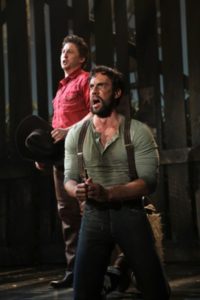 Moving a play from the page to the stage is a long, complex process. For Billy and Me, my second play, which opens at Palm Beach Dramaworks on December 8, that process, which began last year with a series of workshops led by Bill Hayes, the play’s director, has started to pick up speed. I recently signed off on the first part of the ad campaign, and a video teaser for the play was released on Friday. It features Nicholas Richberg and Tom Wahl, who’ll be playing the parts of Tennessee Williams and William Inge, the principal characters in Billy and Me, which is a fictionalized memory play about the two men’s complex and turbulent real-life friendship.
Moving a play from the page to the stage is a long, complex process. For Billy and Me, my second play, which opens at Palm Beach Dramaworks on December 8, that process, which began last year with a series of workshops led by Bill Hayes, the play’s director, has started to pick up speed. I recently signed off on the first part of the ad campaign, and a video teaser for the play was released on Friday. It features Nicholas Richberg and Tom Wahl, who’ll be playing the parts of Tennessee Williams and William Inge, the principal characters in Billy and Me, which is a fictionalized memory play about the two men’s complex and turbulent real-life friendship.
You can view it here:
If that little taste makes you curious, Billy and Me goes into rehearsal on November 7 and preview performances begin in West Palm Beach on December 6. Tickets go on sale on September 12.
For more information, go here.


 Mrs. T and I usually spend a couple of weeks each summer seeing shows in New England and Canada for The Wall Street Journal. That’s what we’re doing now. On Saturday we drove north from Connecticut to Maine, where we
Mrs. T and I usually spend a couple of weeks each summer seeing shows in New England and Canada for The Wall Street Journal. That’s what we’re doing now. On Saturday we drove north from Connecticut to Maine, where we  On Tuesday we checked out of Cliff House and drove to Portland, where we spent a happy hour looking at
On Tuesday we checked out of Cliff House and drove to Portland, where we spent a happy hour looking at  We paused in Buffalo on Wednesday to lunch on
We paused in Buffalo on Wednesday to lunch on  The Shaw Festival, as I’ve learned over the past few years, is one of the foremost classical theater festivals in North America. We plan to spend the next three days seeing Alan Bennett’s The Madness of George III, Brian Friel’s Dancing at Lughnasa, and Shaw’s Saint Joan, which is a sufficiently stiff dose of serious playgoing for one visit. Unless my resolve slackens, I’ll write up each show immediately after I see it. Then we’ll return to the road on Monday, stopping yet again at Charlie the Butcher and spending another night in Utica en route to New Hampshire, where the Peterborough Players’ production of a second Shaw play,
The Shaw Festival, as I’ve learned over the past few years, is one of the foremost classical theater festivals in North America. We plan to spend the next three days seeing Alan Bennett’s The Madness of George III, Brian Friel’s Dancing at Lughnasa, and Shaw’s Saint Joan, which is a sufficiently stiff dose of serious playgoing for one visit. Unless my resolve slackens, I’ll write up each show immediately after I see it. Then we’ll return to the road on Monday, stopping yet again at Charlie the Butcher and spending another night in Utica en route to New Hampshire, where the Peterborough Players’ production of a second Shaw play,  Three-quarters of a century after it opened on Broadway and ran for a then-unprecedented 2,212 performances, it’s easy to forget that “Oklahoma!” was one of the most innovative and influential of all Broadway musicals, not merely for Agnes de Mille’s oft-imitated dream-ballet sequence but also for the way in which Richard Rodgers and Oscar Hammerstein II integrated their songs into the dramatic flow of Hammerstein’s book. Even more important, Hammerstein built darkness and conflict into what could have been a lightweight show by portraying Jud Fry (Matt Faucher) as a tortured soul who is obsessed with the sexually innocent Laurey (Samantha Bruce). That wasn’t the way musicals worked in 1943—most of them were as fluffy as lemon meringue—but Rodgers and Hammerstein believed that the Broadway musical would never ripen into a serious form of popular art unless it was driven by strong dramatic conflict….
Three-quarters of a century after it opened on Broadway and ran for a then-unprecedented 2,212 performances, it’s easy to forget that “Oklahoma!” was one of the most innovative and influential of all Broadway musicals, not merely for Agnes de Mille’s oft-imitated dream-ballet sequence but also for the way in which Richard Rodgers and Oscar Hammerstein II integrated their songs into the dramatic flow of Hammerstein’s book. Even more important, Hammerstein built darkness and conflict into what could have been a lightweight show by portraying Jud Fry (Matt Faucher) as a tortured soul who is obsessed with the sexually innocent Laurey (Samantha Bruce). That wasn’t the way musicals worked in 1943—most of them were as fluffy as lemon meringue—but Rodgers and Hammerstein believed that the Broadway musical would never ripen into a serious form of popular art unless it was driven by strong dramatic conflict….
 Consider what happened to Dana Schutz, a white artist of impeccably liberal views who was represented in this year’s Whitney Biennial by a painting called “Open Casket” (2016). It depicts in a non-realistic, wholly respectful manner the disfigured body of Emmett Till, a black teenager who was lynched in Mississippi in 1955 by southern racists. Protesters tried to have the painting removed from the show, and one, Hannah Black, went so far as to demand that it be “destroyed,” arguing that “it is not acceptable for a white person to transmute black suffering into profit and fun.” The Whitney, quite rightly, refused to cooperate, but the auto-da-fé continued last month when Boston’s Institute of Contemporary Art mounted an exhibition of Ms. Schutz’s work, inspiring a group of black artists to demand that the ICA “pull the show.” To be sure, “Open Casket” wasn’t in it—but did that matter? Not in the slightest. Since Ms. Schutz had created a piece of what the protesters called “racist iconography,” the ICA thus had no right to exhibit any of her work. It’s a wonder they didn’t also suggest that she be flogged in Boston Common.
Consider what happened to Dana Schutz, a white artist of impeccably liberal views who was represented in this year’s Whitney Biennial by a painting called “Open Casket” (2016). It depicts in a non-realistic, wholly respectful manner the disfigured body of Emmett Till, a black teenager who was lynched in Mississippi in 1955 by southern racists. Protesters tried to have the painting removed from the show, and one, Hannah Black, went so far as to demand that it be “destroyed,” arguing that “it is not acceptable for a white person to transmute black suffering into profit and fun.” The Whitney, quite rightly, refused to cooperate, but the auto-da-fé continued last month when Boston’s Institute of Contemporary Art mounted an exhibition of Ms. Schutz’s work, inspiring a group of black artists to demand that the ICA “pull the show.” To be sure, “Open Casket” wasn’t in it—but did that matter? Not in the slightest. Since Ms. Schutz had created a piece of what the protesters called “racist iconography,” the ICA thus had no right to exhibit any of her work. It’s a wonder they didn’t also suggest that she be flogged in Boston Common.